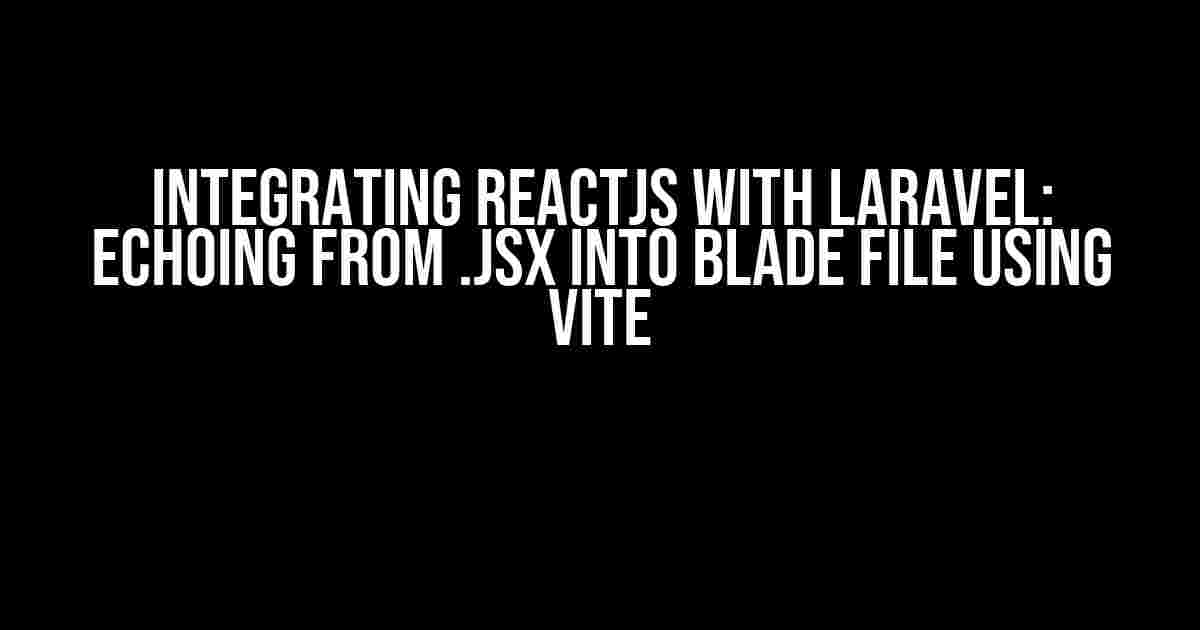As a developer, you may encounter situations where you need to integrate a ReactJS application with a Laravel backend. One of the challenges you might face is echoing data from a .jsx file into a Blade file. In this article, we will explore how to achieve this using Vite, a modern development server.
Why Integrate ReactJS with Laravel?
Laravel is a popular PHP framework for building robust and scalable web applications, while ReactJS is a widely used JavaScript library for building interactive user interfaces. By combining the two, you can leverage the strengths of each technology to create a powerful and dynamic web application.
The Challenge: Echoing from .jsx into Blade File
When working with ReactJS and Laravel, you may need to pass data from a .jsx file to a Blade file. However, since .jsx files are executed on the client-side, and Blade files are executed on the server-side, it’s not straightforward to echo data from a .jsx file into a Blade file.
The Solution: Using Vite to Integrate ReactJS with Laravel
Vite is a modern development server that provides a fast and efficient way to develop and build web applications. By using Vite, you can integrate your ReactJS application with your Laravel backend and echo data from a .jsx file into a Blade file.
Step 1: Set up Vite in Your Laravel Project
To start, you need to install Vite in your Laravel project using the following command:
composer require laravel/vite
Next, you need to configure Vite by creating a vite.config.js file in the root of your project:
import { defineConfig } from 'vite';
import laravel from 'laravel-vite-plugin';
export default defineConfig({
plugins: [
laravel(['resources/js/app.jsx'])
]
});Step 2: Create a ReactJS Component
Create a new ReactJS component in your resources/js directory, for example, app.jsx:
import React from 'react';
function App() {
const data = 'Hello from ReactJS!';
return (
);
}
export default App;Step 3: Echo Data from .jsx into Blade File
In your Blade file, you can use the following code to echo the data from the ReactJS component:
<div id="app">
@php
$data = '';
@endphp
{!! $data !!}
</div>In the above code, we use the React::Component helper function to render the ReactJS component and assign it to the $data variable. We then use the {{ and }} {!! Blade syntax to echo the data.
Conclusion
In this article, we have demonstrated how to integrate a ReactJS application with a Laravel backend using Vite. By following the steps outlined above, you can echo data from a .jsx file into a Blade file and take advantage of the strengths of both technologies.
By leveraging the power of Vite, you can build fast, efficient, and scalable web applications that combine the best of both worlds.
- Use Vite to integrate your ReactJS application with your Laravel backend.
- Create a ReactJS component and export it.
- Use the
React::Componenthelper function to render the ReactJS component in your Blade file. - Echo the data from the ReactJS component into your Blade file using the
{{and}} {!!Blade syntax.
With this approach, you can build complex and dynamic web applications that leverage the strengths of both ReactJS and Laravel.
Frequently Asked Question
Get ready to amplify your ReactJS and Vite skills! Here are the top 5 questions and answers about echoing from .jsx into Blade file.
Q1: What is the main challenge when echoing from .jsx into a Blade file?
The primary challenge lies in escaping the JavaScript syntax within the Blade template, ensuring that the JSX code is executed correctly on the client-side without interfering with the Blade template engine.
Q2: How do I render React components in a Blade file using Vite?
To render React components in a Blade file, use the `{!! !!}` syntax to echo the React component, and make sure to wrap it in a div with an ID. Then, in your JavaScript file, use `ReactDOM.render()` to target that div and render the component.
Q3: What is the role of Vite in echoing from .jsx into a Blade file?
Vite serves as a development server that enables hot module replacement, allowing you to see the changes in your React application automatically. It also optimizes the build process, making it an ideal tool for echoing from .jsx into a Blade file.
Q4: How do I pass data from my Blade file to my React component?
You can pass data from your Blade file to your React component by using a JavaScript variable or a library like `react-dom/server`. Then, use the `window` object to access the data in your React component.
Q5: What are some best practices for echoing from .jsx into a Blade file?
Some best practices include keeping your React components separate from your Blade templates, using a consistent naming convention, and making sure to escape any JavaScript syntax within your Blade templates.





